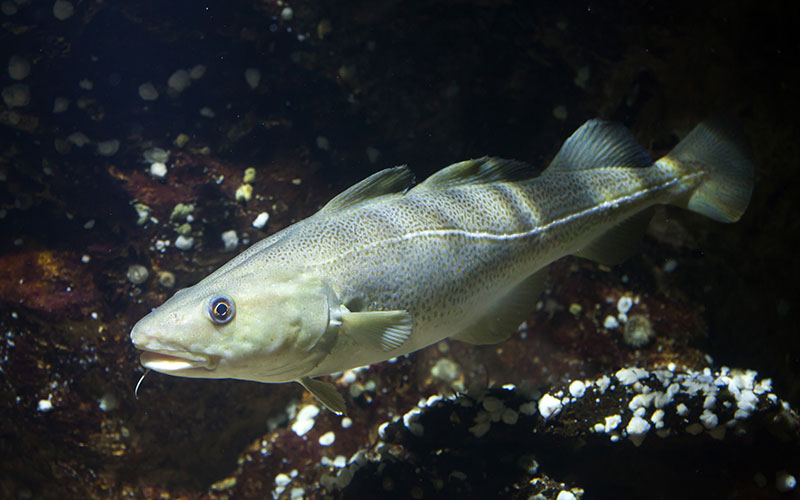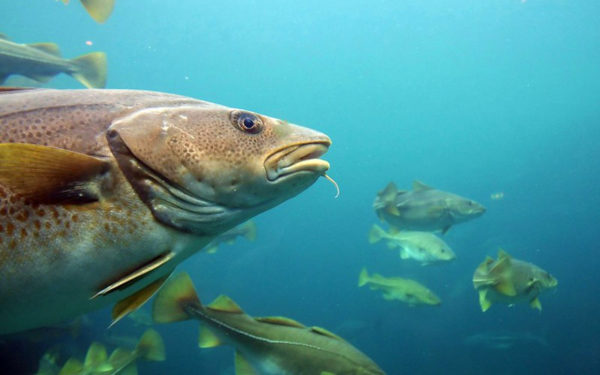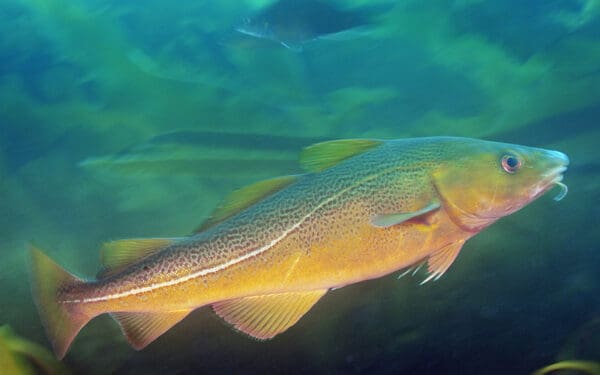
Atlantic cod can still rebound from its overfished state, but it will require better management of the fishery. Photo: Vladimir Wrangel via Shutterstock
This is part two of a three-part series on the current state of Atlantic cod in New England. Part two explores how poor decisions by New England’s fishery managers have led to cod’s demise. Read part one about the problem of inaccurate data here.
New England’s storied cod population is on brink of collapse. The iconic fish that gave Cape Cod its name has been in decline for decades because of intense fishing and poor management. Our regional and federal fishery managers are tasked with maintaining a healthy Atlantic cod population. Yet they have a long record of making management decisions that do more harm than good. Our most iconic fish could still rebound, but it will take urgent action to ensure our grandchildren will be able to enjoy fresh, local cod for dinner.
New England Fishery Managers Imperil Cod’s Survival
Our federal fisheries law, the Magnuson-Stevens Act, mandates that regional fishery managers prevent overfishing. And, when stocks are overfished, managers are required to rebuild them. The New England Fishery Management Council – one of eight councils nationwide overseen by the federal National Marine Fisheries Service (NMFS) – is responsible for carrying out these mandates for healthy fisheries in our region. This includes setting limits on how many cod can be caught and where fishers can cast their nets.
However, for years, these fishery managers, enabled by ineffective federal oversight, have favored short-term profits over the long-term health of the cod fishery. As a result, cod continues to be overfished decade after decade. It is still not on track to rebuild to a sustainable population any time in the foreseeable future.
This is not particularly surprising given that most members of the New England Fishery Management Council have direct ties to commercial fishing. But councils in other parts of the country are similarly constituted and have done better in balancing commercial interests with the health of a particular species, so there’s really no excuse for the poor performance of our local managers.
Management Can’t Work on the Honor System
The mismanagement of New England cod starts with inaccurate data about the number of cod actually being caught. Because federal managers allow most fishing boats to operate on an honor system with few checks and balances, we know little about what’s actually happening on the water.
But we do know that for decades, our management council has put small, immediate gains above making the fishery sustainable for the future. In 1989, when cod were first declared overfished under the Magnuson-Stevens Act, instead of taking action, the managers punted the issue down the road. They argued about meaningless changes in trawl gear specifications while the future of cod and the cod fishery was being destroyed out on the water.
In 1991, the situation was so dire that CLF sued NMFS, producing the first meaningful effort to stop overfishing on cod. While this improved the situation temporarily, managers and the fishing industry continued to pummel the stock with rampant overfishing. By 1995, the cod population had plummeted to its lowest levels in the centuries-old historic record. Fast forward 20 years to today, and cod remain a fraction of what’s considered a healthy population level.
Cod Need More Protected Areas and Lower Catch Limits
Last year, the management council and federal government approved a new plan for managing and protecting cod habitat throughout New England federal waters.
However, instead of protecting essential habitat where the imperiled cod and other species feed, spawn, breed, and grow to maturity, the plan reduced the total amount of area that was, at the time, protected from negative impacts of fishing gear. In area after area, managers chose short-term economic interests over both the cod and the long-term sustainability of fishing fleets. They even ignored their own data and rejected areas for protection that would have led to long-term benefits for fishers. To restore the population, Atlantic cod need more protected areas in New England’s ocean, not fewer.
Despite the unhealthy state of Atlantic cod, fishery managers recently increased the cod catch limits offshore on Georges Bank, a historically important fishing area east of Cape Cod. It is counterproductive to increase the number of cod that can be caught; it is irresponsible to even have a directed fishery for cod. Fishery managers need to keep catch limits as low as possible and focus on effective monitoring and enforcing those low limits out at sea.
Management Must Create a Sustainable Future for Atlantic Cod
The formula for cod recovery is straightforward: good science based on accurate data of catch-at-sea, reducing fishing on cod to the greatest extent practicable, and large closed areas. Without any of those prerequisites, cod doesn’t stand much chance.
Under the Magnuson-Stevens Act, the buck stops with the federal managers. They are supposed to serve everyone’s interests in having a viable and healthy cod fishery. In order for Atlantic cod to recover, the federal government can’t keep allowing fishery managers to violate the letter and spirit of federal law. And promises, good intentions, and hopes won’t produce more fish.
If we want local, sustainable cod in the future, we need better management today.



